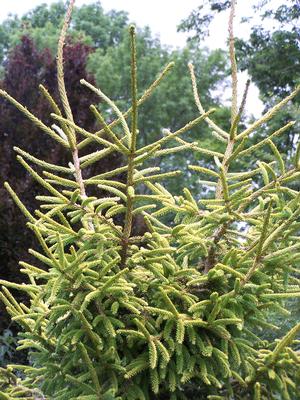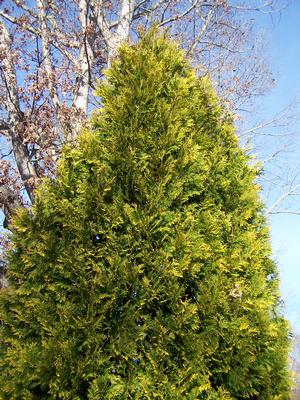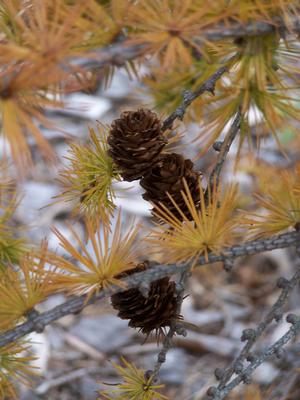
Picea orientalis 'Skylands'

Thuja occidentalis 'Lutea' the big brother of T. occidentalis 'Yellow Ribbon'

Beautiful golden needles of Larix kaempferi before leaf fall in autumn
The Quiet Golden Age
A dazzling array of conifers exists. From mini to massive on the long and growing scroll they will form-fit every design situation. Whether in conditions wet to dry, blazing sun or full shade: choices abound for every environment, too. With four season interest on their side and low to no maintenance requirements isn’t it time to consider this extraordinary group of trees, shrubs and groundcovers in the midst of a quiet golden age?
There are just too many really striking, fine forms from buns to giants to mention here. This article is set to spark your interest and seek out through texts or an internet search just the right golden needled beauty to fit that special spot to which you insist upon an aura of light.
In this vein I’d like to recommend 9 gold-leaf conifers from 6 genera. With so many gold cultivars I made choices based on ease of care, differing size, shape and availability. These will fill a range of environments and design needs in zone 5 and in some cases colder. May this strike a flame in the cresset of your heart for one of my favorite class of shrubs and trees.
Chamaecyparis obtusa ‘Fernspray Gold’, an outstanding cultivar of Hinoki Cypress believed long lost to the trade surfaced, fortunately for us, in New Zealand. The arching branches, held nearly horizontal, radiate from the central trunk(s). Each elongated flattened branch mimics a heavily ruffled and gilded fern frond. The golden scale-like foliage shades to a rich dark green at the interior of the shrub. The green darkens in winter as the yellow burnishes to a golden orange. ‘Fernspray Gold’ develops very bright yellow foliage in full sun, greener-gold in half shade. This lovely shrub grows upright and broad with a perhaps oval outline eventually. Use it as a specimen or at a foundation. Try it in a mixed border with other conifers or grasses such as Miscanthus sinesis ‘Graziella’.
Classification*: Intermediate
Height x Width: 6 feet x 4 feet in 10 to 12 years
Light: Full Sun to Half Shade
Soil: Good moisture-retentive but draining loam with added humus
Zone: 5 to 8
Chamaecyparis obtusa ‘Lynn’s Golden. Hinoki Cypress. For a wonderful “Ceramic Christmas Tree” plant Chamaecyparis obtusa ‘Lynn’s Golden. This memorable mini exhibits small, dense and beautifully articulated scallops of golden foliage. It looks great placed foreground in a foundation planting or as a specimen in a rock garden. It will hold its own in a dwarf conifer border or a heath and heather garden. With small-leaved rhododendrons like ‘Midnight Ruby’ it would be stunning. This little darlin’ will mound upright with an irregular conical outline.
Classification*: Miniature
Height x Width: 3 feet x 2 feet in 15 years
Light: Full Sun with some winter shade if possible but not absolutely necessary
Soil: Good moisture-retentive but draining loam with added humus
Zone: 5 to 8
Chamaecyparis pisifera, commonly called Sawara Cypress, hosts a number of gold cultivars. Many gardeners are familiar with ‘Golden Mop’ and for good reason. A mutation of C. p. ‘Filifera Aurea’, it shows-off the brightest yellow of the Golden Thread-leaf Cypresses. Happiest in full sun, this dwarf will also “do” in part shade forming a bushy wild-haired mound with the outline of a flattened gumdrop. The long, weeping strands of foliage are, indeed, thread-like giving this shrub an unusual soft appearance like an umbrella-shaped fountain of liquid butter erupting from a vigorous spring. Some individuals may develop a leader. If you let it grow the shrub will become pyramidal, otherwise, prune the stem down to maintain a rounded mound. These look great as a short hedge or in the foreground of a mixed shrub/conifer planting. For four season interest in a perennial garden it’s hard to beat. One or more would be gorgeous in front of large leaved rhododendrons and any deciduous shrubs with beautiful winter bark color such as hard-pruned Salix alba ‘Britzensis’. With its contrasting upright dark purple stems Salix purpurea ‘Canyon Blue’ would make a terrific partner.
Classification*: Dwarf
Height x Width: 2 ½ x 3 in 10 to 12 years
Light: Full Sun for best foliage color
Soil: Good moisture-retentive but draining loam
Zone: 4 to 8
Juniperus communis ‘Gold Cone’ - Common Juniper. If you’re looking for a tight, symmetrical column with clean lines for full sun then Juniperus communis ‘Gold Cone’ is a great choice. Though a dwarf this form of Eastern Common Juniper can make a great vertical accent wherever it is used, even in a rock garden. The gray/lime-green foliage with a gold cast on countless vertical branches gives this shrub a solid yet soft look. ‘Gold Cone’ will tolerate xeric conditions once established. I have planted one in a cactus and succulent border where it looks terrific among the stone and boulder. This could make a quite formal, low-maintenance hedge or a vertical specimen wherever a not too big accent might be needed such as a heath and heather garden. Two could act as sentries either side of a walkway leading to the front door of a home or at the entrance of a sunny garden path.
Classification*: Dwarf
Height x Width: 4 to 5 x 1 ½ feet in 10 to 12 years
Light: Full Sun
Soil: Well-drained, add sand if soil is heavy
Zone: (2?)3 to 6(7)
Juniperus horizontalis ‘Mother Lode’ - Rug Juniper. Juniperus horizontalis ‘Mother Lode’ originated as a sport on J. h. ‘Wiltonii’. Though a moderate grower this Golden Rug Juniper has proven extremely slow here at the nursery having spread less than 2 feet by one inch thick in 5 years. This is testament to the fact that once established ‘Mother Lode’ can well tolerate adverse conditions for it is planted in sandy scrabble! It will grow quicker in better soil and modestly layer as it goes. Among stone and boulder this groundcover is like a pool of molten butter that seeped away from the fountain of ‘Golden Mop’. Its beautiful yellow foliage burnishes golden bronze in winter. It would be formidable quilted among other mat-forming junipers and creeping phlox on a sandy bank performing the duty of erosion control. And, too, set as an edger facing-up its taller neighbors in a mixed, multi-planed design scheme. What about ‘Mother Lode’ adjacent to Ophiopogon planiscapus ‘Nigrescens’ and Cornus stolonifera ‘Kelseyi’?
Classification*: Intermediate
Height x Width: 4 inches high eventually, creeps 6 to 12 inches per year
Light: Full Sun
Soil: Not fussy, well-drained
Zone: 4 to 9
Metasequoia glyptostroboides ‘Ogon’ - Dawn Redwood. From evergreen and small we go to deciduous and enormous. Metasequoia glyptostroboides ‘Ogon’, a.k.a. ‘Gold Rush’, is a beautiful gold-needled Dawn Redwood. This Chinese species was thought to be extinct. This cultivar comes to us from Japan. ‘Ogon’ will rise 13 feet tall by 6 feet wide in 10 years and top-off at 35 or 40 feet, so I’ve been told. It is a dwarf compared to its green brother which can mature at 115 feet! In spring the lovely new growth emerges soft yellow and remains all summer ‘til late season. In autumn before the needles fall they change color ranging from golden bronze to rich orange brown. Beautiful in winter, too, the outline of this gentle giant is an upright, statuesque pyramid clothed in rich cinnamon-brown bark supported by a heavily muscled and fluted trunk. Set them paired in rows along a grand allee affording them plenty of room to grow. Use one as a lawn specimen near a body of water with a weeping willow as a cohort. This would make a spectacular addition on a large property, a park or an estate. But for goodness sake: do not plant one too close to a building!
Classification*: Large
Height x Width: 13 feet by 6 feet in 10 years, fast grower
Light: Full Sun to Partial Shade
Moisture: Good loam, constantly moist to wet
Zone: (4)5 to 8
Picea orientalis ‘Skylands’ - Oriental Spruce. I remember spying Picea orientalis ‘Skylands’ at a nursery many years ago and falling instantly in love. I even fell in love with the name. Short, close-packed soft golden needles coat the stems of this relatively slow grower. In that the needles are finer and shorter than most spruce, the architecture of the plant is plainly evident. The trunk bears main branches from which secondary branches fork and in turn produce branch tips like countless yellow fat fingers. When the brilliant new growth is young and tender the overall look of the branch structures is that of large broad layered weeping fans enhancing this Golden Oriental Spruce’s sculptural appeal. Younger plants may burn a bit in full late-season and winter sun but they do outgrow this trait. ‘Skylands’ also forms stunning rich red cones. They are glorious hanging from the golden arms. Gradually they lengthen and morph to brown. Plant one as a specimen. Use it in larger mixed planting with deciduous trees and shrubs that produce persistent berries in winter such as Malus ‘Donald Wyman’ or Viburnum ‘Cardinal Candy’. As a member of a large mixed evergreen screen or hedgerow ‘Skylands’ would be extravagant.
Classification*: Intermediate
Height x Width: 15 feet tall in 10 years
Light: Full Sun to Part Shade
Moisture: Good moisture-retentive but draining loam with added humus
Zone: 4 to 7
Pinus sylvestris ‘Gold Coin’ - Scots Pine. To gaze upon Pinus sylvestris ‘Gold Coin’ in summer is to think you’ve been cheated from the gold-needled cultivar you paid good money for. But don’t run back to the seller with your Golden Scots Pine just yet… Come winter this wonderful tree changes from the rich green of the growing season to a remarkable yellow. An upright pyramid, it will form an amazing sentinel in the winter landscape.
Lighthouse,
Golden beacon in
Endless white,
Seas of wind-danced froth and waves
In the wild season of night
Candle,
Burning soldier,
Sentry of my winter’s heart
Against black might,
Golden spark…
Light pointing towards light.
Plant it in a large conifer/mixed tree and shrub garden contrasted with other-colored winter interest plants such as Salix x ‘Scarlet Curls’, Ilex verticillata ‘Stop Light’ or Viburnum x lobophyllum ‘Oneida’. Mix in different colors and shapes of conifers for a large hedgerow or screen. But best of all: it will make a fabulous specimen. Plant it in full blazing sun. Be sure to site it where you can enjoy it in winter perhaps adjacent to a stand of Cornus stolonifera ‘Cardinal’.
Classification*: Intermediate
Height x Width: 8 feet tall in 10 to 12 years
Light: Full Sun
Soil: Not fussy as long as the drainage is good
Zone: 3 to 7a
Thuja occidentalis ‘Yellow Ribbon’ - Arbor vitae. Some conifers straddle the categories of growth rate. Thuja occidentalis ‘Yellow Ribbon’ revels in the nexus between intermediate and large. Its composition is multitudes of variously arranged flat fans set thickly within the outline of a narrow symmetrical upright cone. Though I am not a strong supporter of arborvitae in that it has been over used as to be a bad cliché I am struck by the beauty of this tree. The gilded sprays of fans hold color well all year in full sun. And though perfectly content in light shade the gold will temper. You can plant a pair as front door sentries. Use one as a distinguished marker at the threshold of a garden path. Use it in a mixed hedgerow as one element among other conifers and deciduous shrubs. Plant one as a vertical accent in a perennial border or at the corner of a large home near a weeping deciduous tree such as Acer japonica ‘Orangeola’ or Prunus ‘Snow Fountain’.
Classification*: Intermediate to Large
Height x Width: 8 to 10 feet x 2 to 3 feet
Light: Better foliage color in Full Sun, more muted in Light Shade
Soil: Good moisture-retentive soil
Zone: 3 to 7
Remember, this is but the smallest sampling of all that is available. There are so very many golden needled conifers. There are witch’s brooms of Hinoki Cypress tiny enough for life in a partly shaded trough. And there is old-fashioned large growing Chamaecyparis obutsa 'Crippsii' with an upright pyramidal appearance, beautiful bark and gorgeous fans of Hinoki Cypress foliage. More narrow in upright form is large growing Thuja occidentalis 'Lutea' and its smaller growing cousin, Thuja orientalis 'Raffles' with handsomely sculpted flattened sprays of foliage which make for a most handsome flame-shaped shrub... Don't forget the deciduous members whose needles yellow in autumn before leaf drop - the gigantic green ginkgos whose geisha fan-like modified needles transform to bright bullion in the autumn sun. Larches and Pseudolarix amabilis though deciduous are both members of Coniferophyta. When autumn comes their needles turn straw yellow to golden yellow before dropping to the ground where they produce a pool of light... And, of course, yellow-foliaged evergreen members are merely one galaxy filled with bright stars in the astral show of green, variegated and blue species, forms and cultivars.
Considering they are largely low-maintenance and so versatile if you have not contemplated golden conifers then let me leave you with something to ponder… Though they are glorious in all seasons these exceptional plants will light the way when we are most in need: the aura of light during the dark days. Indeed, they are the torch bearers leading the way from winter to life renewed. The cresset of my heart is alight. May yours flame bright with possibility.
We are in the midst of a silent renaissance resplendent with all brand of green life. May this in some small way ignite your ardor for the gift of golden-wrapped light.
*The American Conifer Society’s growth rate categories are as follows:
- Miniature: up to 1 inch per year. Estimated size in 10 to 12 years is up to 1 foot.
-
Dwarf: average rate of 1+ to 6 inches per year. Estimated size in 10 to 12 years is 1+ to 6 feet.
-
Intermediate: average rate of 6 to 12 inches per year. Estimated size in 10 to 12 years is 6 to 12 feet.
-
Large: average rate of 12 or more inches per year. Estimated size in 10 to 12 years is 12 feet or more.
Penned by Wayne M. Paquette, February 2005